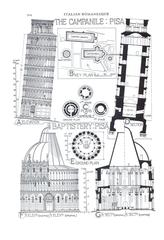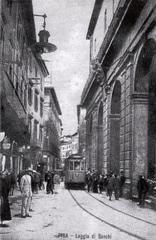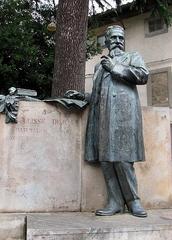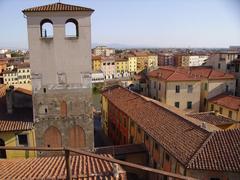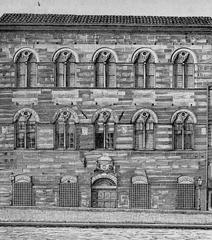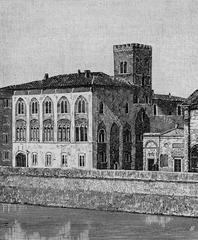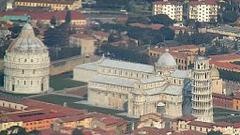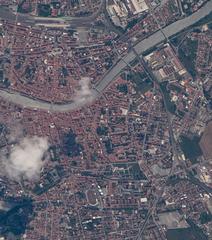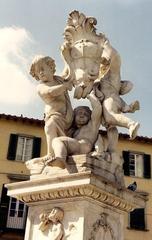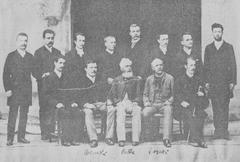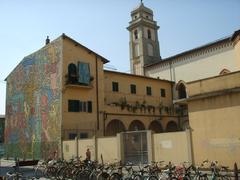Visiting Logge di Banchi in Pisa: Hours, Tickets, and Tips
Publication Date: 19/07/2024
Introduction to Logge di Banchi
Located in the heart of Pisa, Italy, the Logge di Banchi is a historical and architectural marvel that dates back to the early 17th century. Commissioned by the Grand Duke of Tuscany, Ferdinando I de’ Medici, and designed by the esteemed architect Bernardo Buontalenti, the loggia was constructed between 1603 and 1605. Originally intended as a marketplace for merchants dealing in wool and silk, it rapidly became a crucial hub for Pisa’s economic, social, and cultural activities (Pisa Unica Terra). The Logge di Banchi exemplifies Renaissance architecture with its elegant arches and robust columns, embodying the era’s emphasis on symmetry and classical elements (Visit Tuscany). Over the centuries, it has evolved from a bustling commercial center to a significant civic and administrative landmark, reflecting Pisa’s rich heritage and adaptive reuse of historical structures. Today, it stands as a testament to Pisa’s historical resilience and architectural grandeur, attracting visitors from around the world.
Contents Overview
- Introduction
- Origins and Construction
- Architectural Significance
- Role in Pisa’s Economic History
- Transformation Over the Centuries
- Preservation and Restoration Efforts
- Visiting Information
- Visiting Hours
- Tickets
- Address
- Nearby Attractions and Travel Tips
- Accessibility
- Cultural and Social Impact
- Modern-Day Relevance
- Notable Events and Anecdotes
- Architectural Details and Features
- Influence on Later Architecture
- Conclusion
- FAQ
- What are the visiting hours for the Logge di Banchi?
- Is there an admission fee?
- What nearby attractions can I visit?
- Is the Logge di Banchi accessible to visitors with mobility challenges?
- Call to Action
History of Logge di Banchi
Origins and Construction
The construction of the Logge di Banchi began in 1603 and was completed in 1605. Commissioned by the Grand Duke of Tuscany, Ferdinando I de’ Medici, and designed by the renowned architect Bernardo Buontalenti, the loggia was originally intended to serve as a marketplace for merchants dealing in wool and silk, which were vital commodities in Pisa’s economy at the time (Pisa Unica Terra).
Architectural Significance
An exemplary piece of Renaissance architecture, the Logge di Banchi is characterized by its elegant loggia with a series of arches supported by robust columns. The structure is composed of two levels - the ground floor, which was used for commercial activities, and the upper floor, which housed administrative offices. The design reflects the typical Renaissance emphasis on symmetry, proportion, and the use of classical elements such as columns and arches (Visit Tuscany).
Role in Pisa’s Economic History
During the 17th and 18th centuries, the Logge di Banchi was the hub of commercial activities, where merchants from various parts of Italy and beyond would gather to trade goods. This marketplace was particularly important for the wool and silk industries, which were among the most lucrative sectors in Pisa at the time (Pisa Unica Terra).
Transformation Over the Centuries
By the 19th century, the building’s commercial significance had diminished, and it began to serve more administrative and civic purposes. In the early 20th century, the upper floor of the Logge di Banchi was converted into the headquarters of the Chamber of Commerce of Pisa. This transformation marked a shift from its original commercial use to a more institutional role (Chamber of Commerce of Pisa).
Preservation and Restoration Efforts
Several restoration efforts have been undertaken to preserve the Logge di Banchi’s historical and architectural integrity. Notably, in the late 20th century, extensive restoration work was carried out to address structural issues and to restore the building’s façade to its original splendor. These efforts were crucial in maintaining the building as a significant historical landmark in Pisa (Pisa Unica Terra).
Visiting Information
- Visiting Hours: The Logge di Banchi is open to the public from 9:00 AM to 7:00 PM, Monday through Saturday.
- Tickets: Admission is free, but guided tours may have a fee. Check the official website for the latest information.
- Address: Piazza XX Settembre, 56125 Pisa PI, Italy
Nearby Attractions and Travel Tips
- Leaning Tower of Pisa: Just a short walk away, this iconic structure is a must-visit.
- Pisa Cathedral: Another nearby attraction, offering stunning architecture and rich history.
- Travel Tips: Wear comfortable shoes as the area is best explored on foot. Also, make sure to carry a bottle of water, especially during the summer months.
Accessibility
The Logge di Banchi is accessible to visitors with mobility challenges, with ramps and elevators available for ease of access.
Cultural and Social Impact
Throughout its history, the loggia has hosted various public events, including markets, fairs, and civic gatherings. Its central location in the heart of Pisa makes it a popular meeting place for locals and tourists alike. The building’s historical significance and architectural beauty continue to attract visitors, contributing to Pisa’s cultural heritage (Visit Tuscany).
Modern-Day Relevance
Today, the Logge di Banchi remains an important historical and cultural landmark in Pisa. It is a testament to the city’s rich commercial history and architectural heritage. The building is often used for exhibitions, cultural events, and public gatherings, maintaining its role as a vibrant part of Pisa’s urban landscape (Pisa Unica Terra).
Notable Events and Anecdotes
One notable event was the visit of Grand Duke Ferdinando I de’ Medici during its inauguration in 1605, underscoring the importance of the loggia to Pisa’s economy. The building has been featured in various historical records and artworks, highlighting its prominence in Pisa’s urban landscape (Pisa Unica Terra).
Architectural Details and Features
The ground floor features a series of open arches supported by sturdy columns, creating a spacious and airy loggia. The upper floor is adorned with elegant windows and decorative elements that reflect the Renaissance aesthetic. The use of local materials, such as marble and stone, adds to the building’s historical and architectural value. The loggia’s design is a testament to the skill and artistry of Bernardo Buontalenti (Visit Tuscany).
Influence on Later Architecture
The design and construction of the Logge di Banchi had a significant influence on later architectural developments in Pisa and beyond. Its use of classical elements and emphasis on symmetry and proportion became a model for subsequent buildings in the region. The loggia’s architectural style can be seen in other public and commercial buildings constructed in the 17th and 18th centuries (Pisa Unica Terra).
Conclusion
The Logge di Banchi is a remarkable historical and architectural landmark that has played a vital role in Pisa’s economic, social, and cultural life for over four centuries. Its rich history, architectural beauty, and ongoing relevance make it a must-visit destination for anyone interested in the heritage of Pisa. The building stands as a testament to the city’s historical resilience and its commitment to preserving its cultural legacy for future generations (Visit Tuscany).
FAQ
Q: What are the visiting hours for the Logge di Banchi? A: The Logge di Banchi is open from 9:00 AM to 7:00 PM, Monday through Saturday.
Q: Is there an admission fee? A: Admission is free, but guided tours may have a fee.
Q: What nearby attractions can I visit? A: Nearby attractions include the Leaning Tower of Pisa and Pisa Cathedral.
Q: Is the Logge di Banchi accessible to visitors with mobility challenges? A: Yes, the Logge di Banchi is accessible with ramps and elevators available.
Call to Action
For more updates and travel tips, download our mobile app Audiala, check out our other related posts, and follow us on social media!
Sources and Further Reading
- Pisa Unica Terra. (n.d.). History of Logge di Banchi. Retrieved from https://www.pisaunicaterra.it
- Visit Tuscany. (n.d.). Logge di Banchi. Retrieved from https://www.visittuscany.com
- Chamber of Commerce of Pisa. (n.d.). Retrieved from https://www.pi.camcom.it

